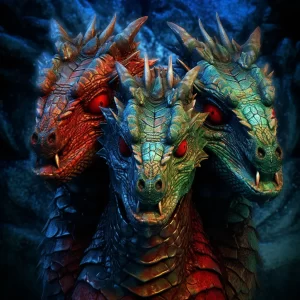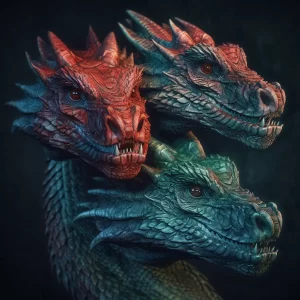Ellén Trechend is a three-headed monster from Irish mythology that has captured the imagination of many over the years. This terrifying Celtic creature is said to have emerged from the Cave of Cruachan and wreaked havoc across Ireland until it was finally slain by the hero Amergin. The story of Ellén Trechend has been passed down through generations and remains a popular topic in Irish folklore today.
According to legend, Ellén Trechend was a fearsome beast with three heads and a voracious appetite for destruction. It is said that the monster was so powerful that it could lay waste to entire villages with a single breath. Despite its formidable reputation, Ellén Trechend was eventually defeated by Amergin, who used his wit and courage to outsmart the beast and deliver the fatal blow.
Ellén Trechend: History and Characteristics
History and Mythology
Ellén Trechend is a three-headed monster of Irish mythology that is mentioned in the text Cath Maige Mucrama (The Battle of Mag Mucrima). According to the myth, it emerged from the cave of Cruachan (Rathcroghan, County Roscommon) and laid waste to Ireland until it was killed by the Ulaid poet and hero Amergin. The creature is also referred to as a monstrous triple-headed bird, and it is said to have been led by a flock of copper-red birds. The Sidhe of Cruachan supposedly opened on Samhain, and a crowd of goblins rushed out, along with Ellén Trechend and its flock of birds.
Physical Characteristics
Ellén Trechend is described as a three-headed monster with fire-breathing capabilities. The creature’s appearance is further described as a monstrous triple-headed bird, with each of its heads capable of spitting fire. The Old Irish Én is translated as “bird,” and T. F. O’Rahilly suggests that the creature’s name may have originally meant “three birds.” The Revue Celtique suggests that Ellén Trechend may have been a mistranslation of an obscure word for a fire-breathing monster like a Dragon. Dragons featured prominently in Celtic mythology.
It is said to have a wingspan that covered the entire sky, and its three heads were said to have been as large as a bull’s head. Each of the heads had a separate color, red, green and blue. It is also said that the creature had razor-sharp talons and a beak that could tear through flesh.
Behavior and Habitat
Ellén Trechend is just one of many mythical creatures in Irish folklore, alongside entities such as the Leprechaun, Abhartach, Far Darrig, Fear Gorta, Sluagh, and the wailing Banshee. These creatures are often associated with Celtic mythology and are said to have been created by the ancient Celts to explain natural phenomena or to represent various aspects of their culture. Bram Stoker’s Dracula is also said to have been inspired by Irish folklore, particularly the faeries and goddesses associated with good fortune and the maid who becomes a vampire.
Ellén Trechend was a fearsome creature that terrorized Ireland, laying waste to everything in its path. It was said to have a voracious appetite and would devour anything in its way, including people and livestock. The creature was known to swoop down from the sky and snatch up its victims with its sharp talons.

The Legend of Ellén Trechend
Significance in Irish Mythology
In literature, Bram Stoker’s Dracula is said to have been inspired by Irish folklore, including Ellén Trechend and other mythical creatures. The Sidhe, or fairies, are also prominent in Celtic mythology and are associated with the supernatural and magical elements of Irish culture.
The Cave of Cruachan
The Cave of Cruachan was believed to be the entrance to the Otherworld, a mystical realm where the Sidhe, or fairy folk, lived. The cave was also believed to be the home of Aillén, a fire-breathing monster who would emerge from the cave every Samhain to burn down the royal palace of Tara. It is possible that the Ellén Trechend was inspired by Aillén or other creatures associated with the cave.
Ellén Trechend in Popular Culture
Ellén Trechend is a well-known creature in Irish mythology, and it has made its way into modern popular culture. Here are a few examples of how Ellén Trechend has been portrayed in popular culture:
- In the video game “World of Warcraft,” there is a boss named “Alysrazor,” which is a reference to Ellén Trechend. Alysrazor is a giant bird with three heads, and it has a similar appearance to Ellén Trechend.
- In the book “Dracula” by Bram Stoker, there is a reference to Ellén Trechend. When Dracula is explaining his ancestry, he mentions that his family is descended from “Attila, my own great race, who gave their name to the Ellenes, who were also called Trechend.” This is a reference to Ellén Trechend, and it shows how deeply ingrained the creature is in Irish mythology.
- In the TV show “Supernatural,” there is an episode called “The Vessel,” which features a creature called a “Thule-Gesellschaft,” which is a reference to the real-life Thule Society. The Thule-Gesellschaft is described as a three-headed monster, and it is a clear reference to Ellén Trechend.
-

Ellén Trechend
Frequently Asked Questions
Who are the Sidhe faerie?
In Irish mythology, the Sidhe (pronounced “shee”) is a supernatural race of faeries or spirits that inhabit the Otherworld, which is believed to exist alongside our own world. They are often depicted as beautiful, ethereal beings with magical powers, and are associated with music, dance, and poetry. The Sidhe are said to be immortal and to have the ability to shape-shift, and they are often depicted as living in underground mounds or hills. In some stories, they are benevolent and helpful to humans, while in others they are mischievous or even malevolent.
What is the Fear Gorta?
The Fear Gorta is a figure from Irish folklore who is said to appear as a starving, emaciated man begging for food. According to legend, he is a spirit who haunts the land during times of famine, and his appearance is a sign that the crops will fail and people will go hungry. The Fear Gorta is often depicted as a pitiful figure, and those who refuse to give him food are said to be cursed with bad luck or even death.
Who is Erin in Irish mythology?
Erin is the poetic name for Ireland in Irish mythology. She is often personified as a goddess or a beautiful woman, and is associated with the land and the natural world. In some stories, Erin is said to be the mother of all the gods and goddesses, and she is often depicted as a symbol of Irish identity and national pride.
How are mermaids depicted in Irish folklore?
In Irish folklore, mermaids are often depicted as beautiful, alluring creatures with long hair and fish tails. They are associated with the sea and with water spirits, and are said to have the ability to control the tides and the weather. In some stories, mermaids are benevolent and helpful to humans, while in others they are dangerous and luring sailors to their deaths.
Who is Carman in Celtic mythology?
Carman is a figure from Irish mythology who is associated with the festival of Lughnasadh, which celebrates the beginning of the harvest season. According to legend, Carman was a powerful sorceress who came to Ireland from the east and brought with her the knowledge of agriculture and the arts. She is said to have been a goddess of fertility and abundance, and her festival was celebrated with feasting, games, and competitions.
Is Etain a Celtic myth?
Yes, Etain is a figure from Celtic mythology who is associated with the Tuatha De Danann, a supernatural race of beings in Irish mythology. She is often depicted as a beautiful woman with magical powers, and is associated with love, beauty, and fertility. Etain is said to have been reborn many times throughout history, and her story is often told as a tale of love, loss, and redemption.


